A Critical Analysis of Employee Motivation Theories in Workplace
VerifiedAdded on 2023/06/05
|9
|2224
|125
Essay
AI Summary
This essay provides a detailed analysis of employee motivation, exploring the concepts of intrinsic and extrinsic motivation and their influence on employee behavior in the workplace. It critically examines three prominent theories of workplace motivation: Vroom's Expectancy Theory, the Job Characteristics Model, and Herzberg's Two-Factor Theory. The essay elucidates the core components of each theory, such as expectancy, instrumentality, and valence in Vroom's theory; skill variety, task significance, and autonomy in the Job Characteristics Model; and hygiene and motivating factors in Herzberg's theory. It also provides practical examples of how these theories can be applied in organizations to enhance employee performance and overall productivity. The essay concludes by emphasizing the critical role of employee motivation in achieving long-term organizational success and the importance of managers effectively employing these motivation theories.
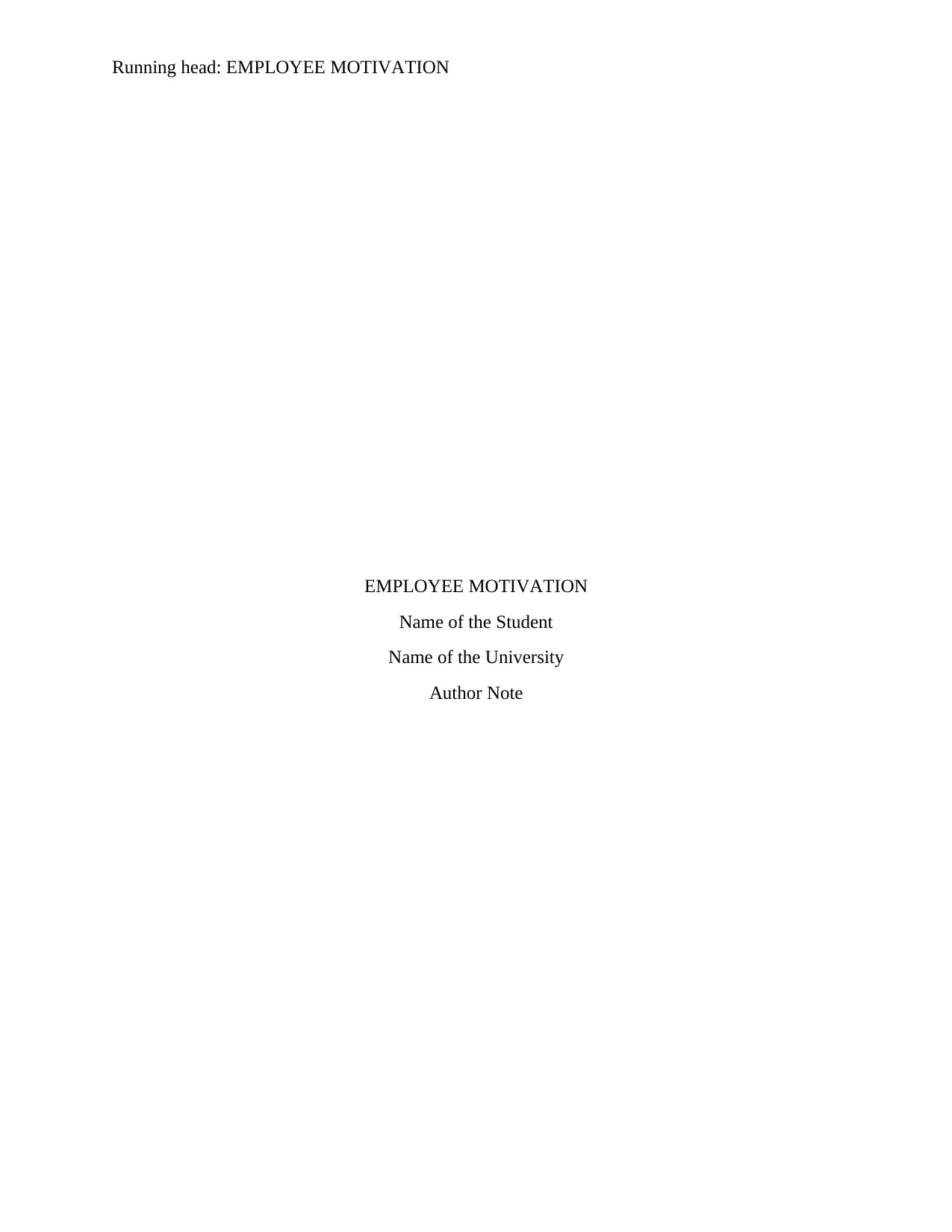
Running head: EMPLOYEE MOTIVATION
EMPLOYEE MOTIVATION
Name of the Student
Name of the University
Author Note
EMPLOYEE MOTIVATION
Name of the Student
Name of the University
Author Note
Paraphrase This Document
Need a fresh take? Get an instant paraphrase of this document with our AI Paraphraser
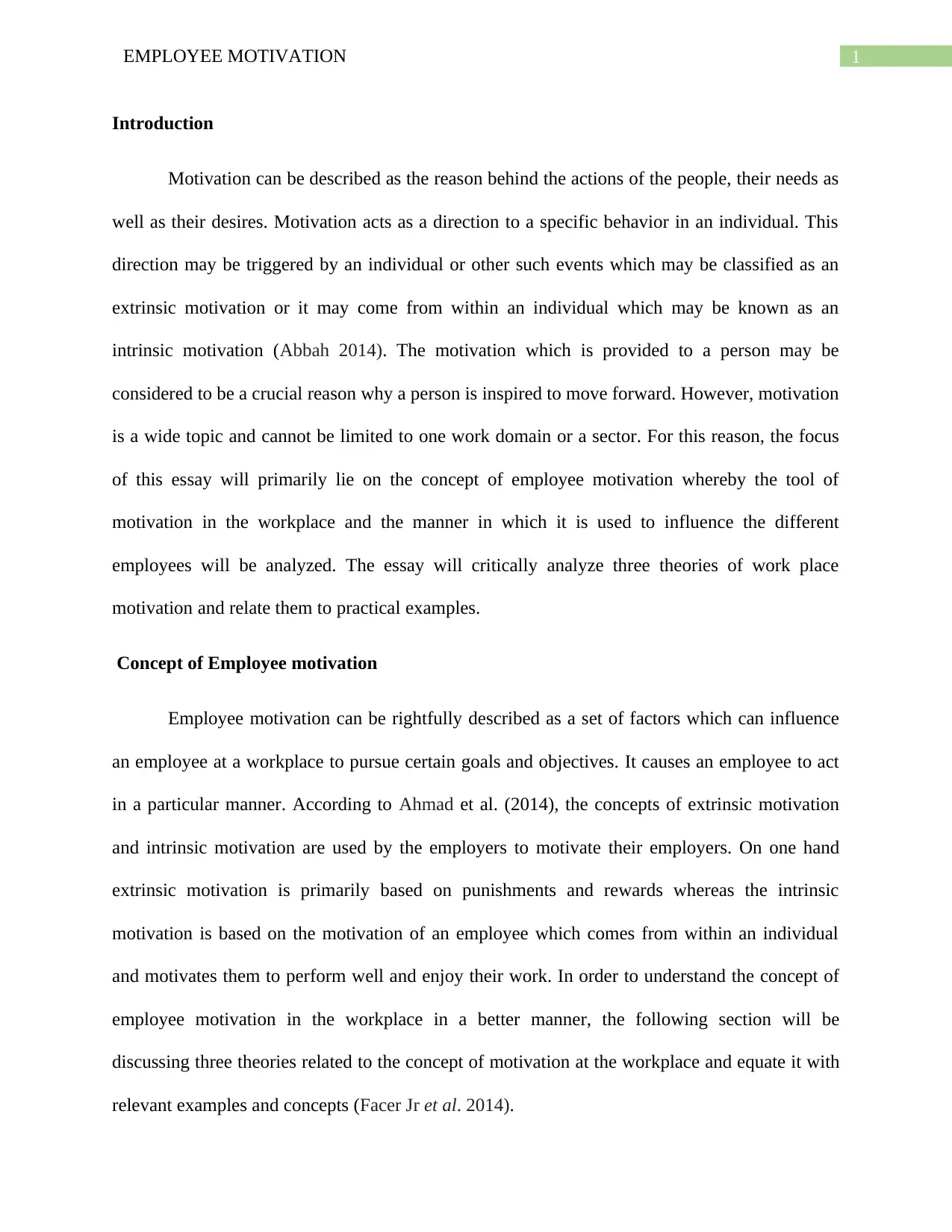
1EMPLOYEE MOTIVATION
Introduction
Motivation can be described as the reason behind the actions of the people, their needs as
well as their desires. Motivation acts as a direction to a specific behavior in an individual. This
direction may be triggered by an individual or other such events which may be classified as an
extrinsic motivation or it may come from within an individual which may be known as an
intrinsic motivation (Abbah 2014). The motivation which is provided to a person may be
considered to be a crucial reason why a person is inspired to move forward. However, motivation
is a wide topic and cannot be limited to one work domain or a sector. For this reason, the focus
of this essay will primarily lie on the concept of employee motivation whereby the tool of
motivation in the workplace and the manner in which it is used to influence the different
employees will be analyzed. The essay will critically analyze three theories of work place
motivation and relate them to practical examples.
Concept of Employee motivation
Employee motivation can be rightfully described as a set of factors which can influence
an employee at a workplace to pursue certain goals and objectives. It causes an employee to act
in a particular manner. According to Ahmad et al. (2014), the concepts of extrinsic motivation
and intrinsic motivation are used by the employers to motivate their employers. On one hand
extrinsic motivation is primarily based on punishments and rewards whereas the intrinsic
motivation is based on the motivation of an employee which comes from within an individual
and motivates them to perform well and enjoy their work. In order to understand the concept of
employee motivation in the workplace in a better manner, the following section will be
discussing three theories related to the concept of motivation at the workplace and equate it with
relevant examples and concepts (Facer Jr et al. 2014).
Introduction
Motivation can be described as the reason behind the actions of the people, their needs as
well as their desires. Motivation acts as a direction to a specific behavior in an individual. This
direction may be triggered by an individual or other such events which may be classified as an
extrinsic motivation or it may come from within an individual which may be known as an
intrinsic motivation (Abbah 2014). The motivation which is provided to a person may be
considered to be a crucial reason why a person is inspired to move forward. However, motivation
is a wide topic and cannot be limited to one work domain or a sector. For this reason, the focus
of this essay will primarily lie on the concept of employee motivation whereby the tool of
motivation in the workplace and the manner in which it is used to influence the different
employees will be analyzed. The essay will critically analyze three theories of work place
motivation and relate them to practical examples.
Concept of Employee motivation
Employee motivation can be rightfully described as a set of factors which can influence
an employee at a workplace to pursue certain goals and objectives. It causes an employee to act
in a particular manner. According to Ahmad et al. (2014), the concepts of extrinsic motivation
and intrinsic motivation are used by the employers to motivate their employers. On one hand
extrinsic motivation is primarily based on punishments and rewards whereas the intrinsic
motivation is based on the motivation of an employee which comes from within an individual
and motivates them to perform well and enjoy their work. In order to understand the concept of
employee motivation in the workplace in a better manner, the following section will be
discussing three theories related to the concept of motivation at the workplace and equate it with
relevant examples and concepts (Facer Jr et al. 2014).

2EMPLOYEE MOTIVATION
Theories of Employee Motivation
Expectancy theory of motivation
The expectancy theory of Vroom is a motivational theory which is based on the
assumption that the behavior of an individual tends to result from the conscious choices which
are made among the alternatives. The primary motivate of these alternatives are to maximize the
pleasure at the workplace and to minimize the pain. According to Vroom, the performance of an
employee is largely based on the skills, personality and abilities of the different employees and
that to increase the performance of the employees the variables of expectancy, instrumentality
and Valence can be rightfully used.
Expectancy
The expectancy can be described as a belief that an increased effort shall lead to a better
performance. According to Ganta (2014), his effort may be from the side of the employee or
from the side of an employer. However, there are various factors which have an impact on the
expectancy which are the resources will are available in the organization, the right kind of skills
as present to conduct the job tactfully and the organizational support. Kuranchie-Mensah and
Amponsah-Tawiah (2016) state that the expectancy can work well if the environment is
conducive.
Instrumentality
The instrumentality can be rightfully described as a belief which states that in cases
where the employee tends to work well the outcome of the organization will be good. This
simply leads to a direction that the degree to which a first outcome is reached will lead to a
second outcome (Shields et al. 2015). This is affected by the factors that the relationship between
Theories of Employee Motivation
Expectancy theory of motivation
The expectancy theory of Vroom is a motivational theory which is based on the
assumption that the behavior of an individual tends to result from the conscious choices which
are made among the alternatives. The primary motivate of these alternatives are to maximize the
pleasure at the workplace and to minimize the pain. According to Vroom, the performance of an
employee is largely based on the skills, personality and abilities of the different employees and
that to increase the performance of the employees the variables of expectancy, instrumentality
and Valence can be rightfully used.
Expectancy
The expectancy can be described as a belief that an increased effort shall lead to a better
performance. According to Ganta (2014), his effort may be from the side of the employee or
from the side of an employer. However, there are various factors which have an impact on the
expectancy which are the resources will are available in the organization, the right kind of skills
as present to conduct the job tactfully and the organizational support. Kuranchie-Mensah and
Amponsah-Tawiah (2016) state that the expectancy can work well if the environment is
conducive.
Instrumentality
The instrumentality can be rightfully described as a belief which states that in cases
where the employee tends to work well the outcome of the organization will be good. This
simply leads to a direction that the degree to which a first outcome is reached will lead to a
second outcome (Shields et al. 2015). This is affected by the factors that the relationship between
⊘ This is a preview!⊘
Do you want full access?
Subscribe today to unlock all pages.

Trusted by 1+ million students worldwide
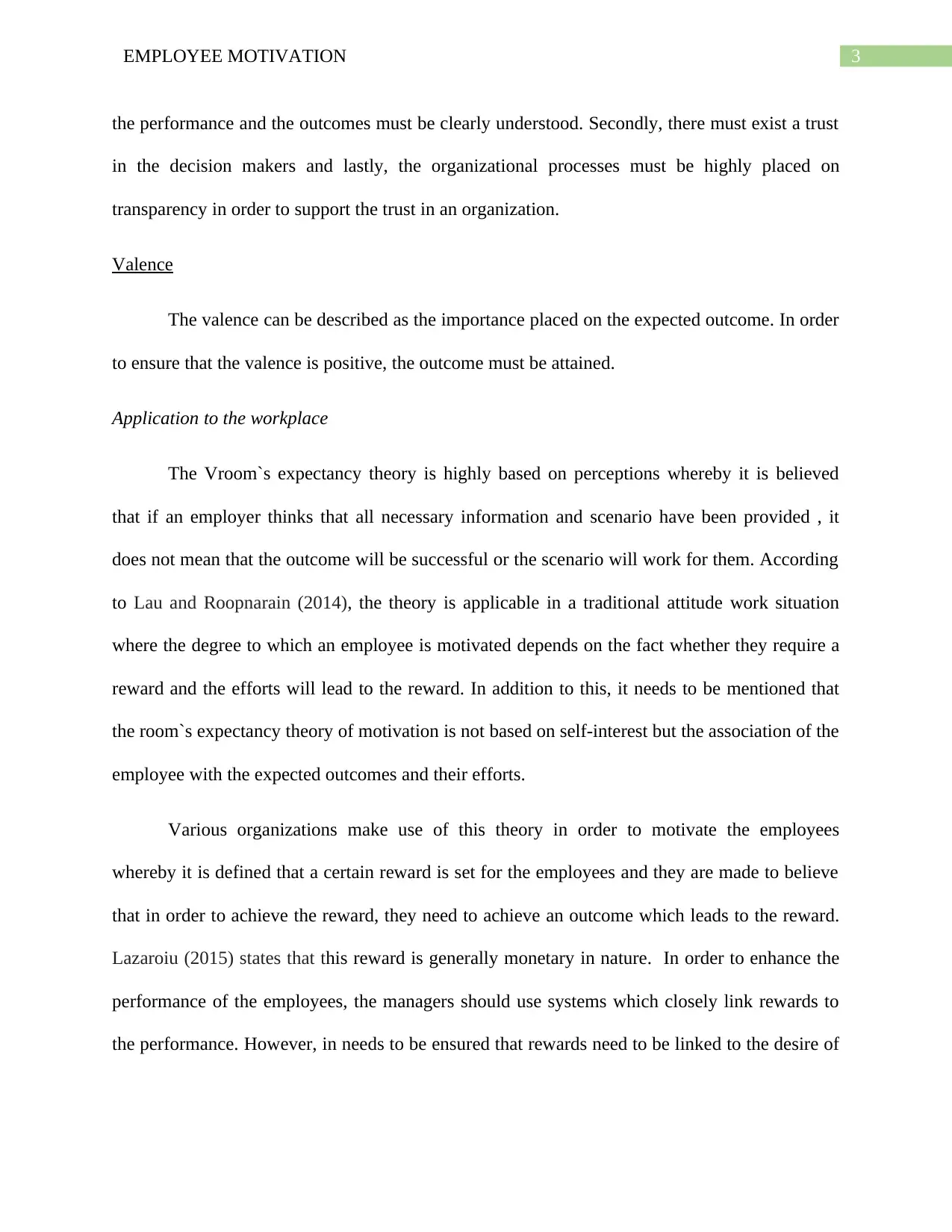
3EMPLOYEE MOTIVATION
the performance and the outcomes must be clearly understood. Secondly, there must exist a trust
in the decision makers and lastly, the organizational processes must be highly placed on
transparency in order to support the trust in an organization.
Valence
The valence can be described as the importance placed on the expected outcome. In order
to ensure that the valence is positive, the outcome must be attained.
Application to the workplace
The Vroom`s expectancy theory is highly based on perceptions whereby it is believed
that if an employer thinks that all necessary information and scenario have been provided , it
does not mean that the outcome will be successful or the scenario will work for them. According
to Lau and Roopnarain (2014), the theory is applicable in a traditional attitude work situation
where the degree to which an employee is motivated depends on the fact whether they require a
reward and the efforts will lead to the reward. In addition to this, it needs to be mentioned that
the room`s expectancy theory of motivation is not based on self-interest but the association of the
employee with the expected outcomes and their efforts.
Various organizations make use of this theory in order to motivate the employees
whereby it is defined that a certain reward is set for the employees and they are made to believe
that in order to achieve the reward, they need to achieve an outcome which leads to the reward.
Lazaroiu (2015) states that this reward is generally monetary in nature. In order to enhance the
performance of the employees, the managers should use systems which closely link rewards to
the performance. However, in needs to be ensured that rewards need to be linked to the desire of
the performance and the outcomes must be clearly understood. Secondly, there must exist a trust
in the decision makers and lastly, the organizational processes must be highly placed on
transparency in order to support the trust in an organization.
Valence
The valence can be described as the importance placed on the expected outcome. In order
to ensure that the valence is positive, the outcome must be attained.
Application to the workplace
The Vroom`s expectancy theory is highly based on perceptions whereby it is believed
that if an employer thinks that all necessary information and scenario have been provided , it
does not mean that the outcome will be successful or the scenario will work for them. According
to Lau and Roopnarain (2014), the theory is applicable in a traditional attitude work situation
where the degree to which an employee is motivated depends on the fact whether they require a
reward and the efforts will lead to the reward. In addition to this, it needs to be mentioned that
the room`s expectancy theory of motivation is not based on self-interest but the association of the
employee with the expected outcomes and their efforts.
Various organizations make use of this theory in order to motivate the employees
whereby it is defined that a certain reward is set for the employees and they are made to believe
that in order to achieve the reward, they need to achieve an outcome which leads to the reward.
Lazaroiu (2015) states that this reward is generally monetary in nature. In order to enhance the
performance of the employees, the managers should use systems which closely link rewards to
the performance. However, in needs to be ensured that rewards need to be linked to the desire of
Paraphrase This Document
Need a fresh take? Get an instant paraphrase of this document with our AI Paraphraser
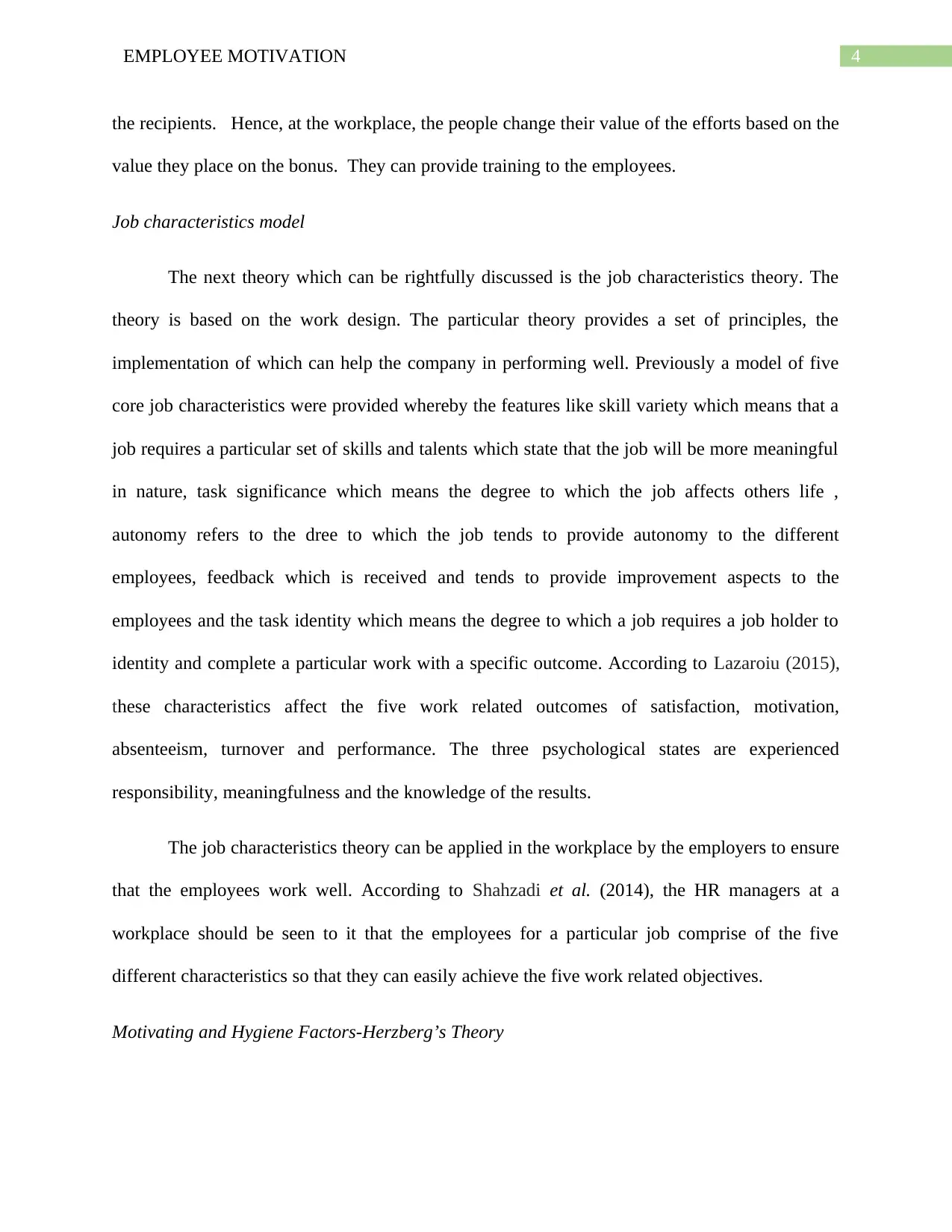
4EMPLOYEE MOTIVATION
the recipients. Hence, at the workplace, the people change their value of the efforts based on the
value they place on the bonus. They can provide training to the employees.
Job characteristics model
The next theory which can be rightfully discussed is the job characteristics theory. The
theory is based on the work design. The particular theory provides a set of principles, the
implementation of which can help the company in performing well. Previously a model of five
core job characteristics were provided whereby the features like skill variety which means that a
job requires a particular set of skills and talents which state that the job will be more meaningful
in nature, task significance which means the degree to which the job affects others life ,
autonomy refers to the dree to which the job tends to provide autonomy to the different
employees, feedback which is received and tends to provide improvement aspects to the
employees and the task identity which means the degree to which a job requires a job holder to
identity and complete a particular work with a specific outcome. According to Lazaroiu (2015),
these characteristics affect the five work related outcomes of satisfaction, motivation,
absenteeism, turnover and performance. The three psychological states are experienced
responsibility, meaningfulness and the knowledge of the results.
The job characteristics theory can be applied in the workplace by the employers to ensure
that the employees work well. According to Shahzadi et al. (2014), the HR managers at a
workplace should be seen to it that the employees for a particular job comprise of the five
different characteristics so that they can easily achieve the five work related objectives.
Motivating and Hygiene Factors-Herzberg’s Theory
the recipients. Hence, at the workplace, the people change their value of the efforts based on the
value they place on the bonus. They can provide training to the employees.
Job characteristics model
The next theory which can be rightfully discussed is the job characteristics theory. The
theory is based on the work design. The particular theory provides a set of principles, the
implementation of which can help the company in performing well. Previously a model of five
core job characteristics were provided whereby the features like skill variety which means that a
job requires a particular set of skills and talents which state that the job will be more meaningful
in nature, task significance which means the degree to which the job affects others life ,
autonomy refers to the dree to which the job tends to provide autonomy to the different
employees, feedback which is received and tends to provide improvement aspects to the
employees and the task identity which means the degree to which a job requires a job holder to
identity and complete a particular work with a specific outcome. According to Lazaroiu (2015),
these characteristics affect the five work related outcomes of satisfaction, motivation,
absenteeism, turnover and performance. The three psychological states are experienced
responsibility, meaningfulness and the knowledge of the results.
The job characteristics theory can be applied in the workplace by the employers to ensure
that the employees work well. According to Shahzadi et al. (2014), the HR managers at a
workplace should be seen to it that the employees for a particular job comprise of the five
different characteristics so that they can easily achieve the five work related objectives.
Motivating and Hygiene Factors-Herzberg’s Theory
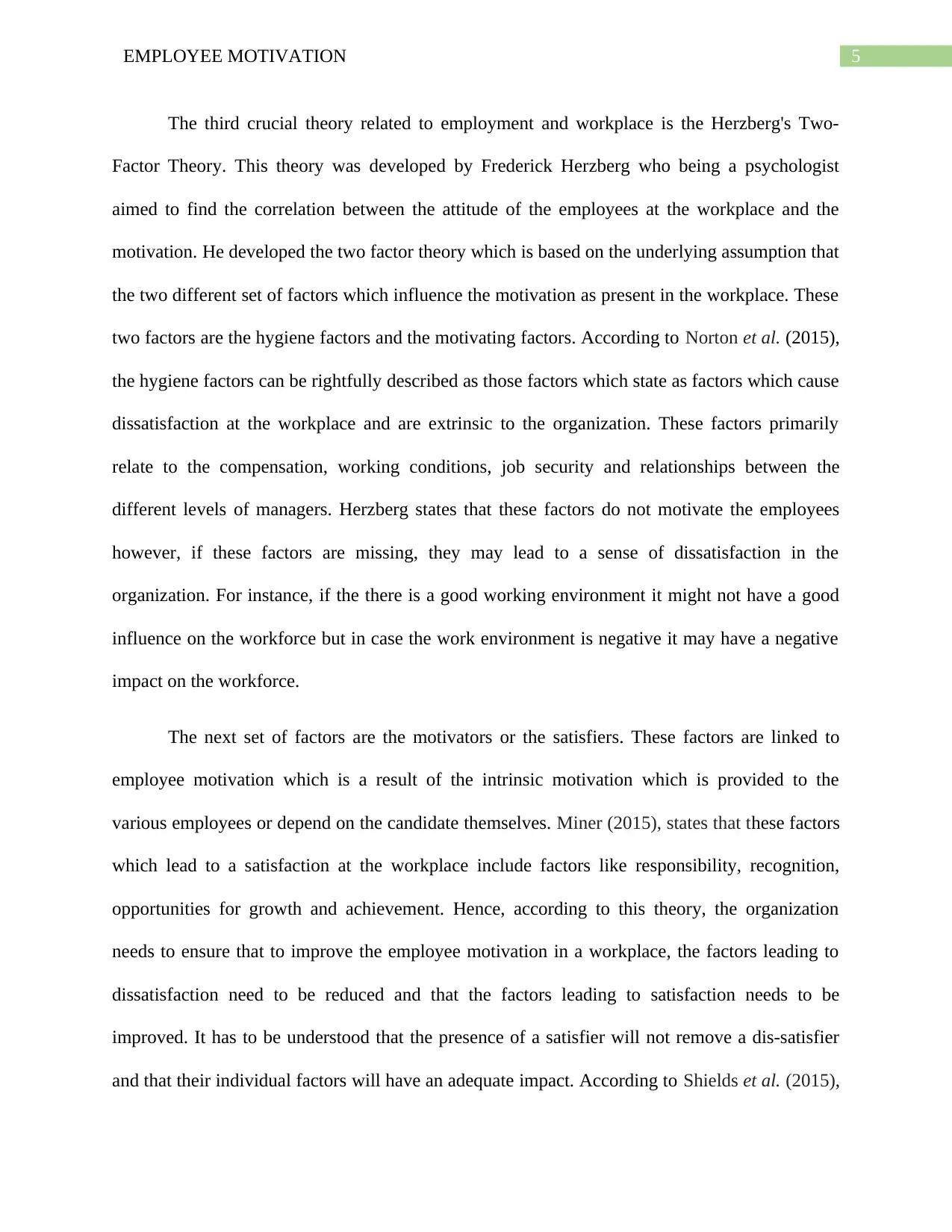
5EMPLOYEE MOTIVATION
The third crucial theory related to employment and workplace is the Herzberg's Two-
Factor Theory. This theory was developed by Frederick Herzberg who being a psychologist
aimed to find the correlation between the attitude of the employees at the workplace and the
motivation. He developed the two factor theory which is based on the underlying assumption that
the two different set of factors which influence the motivation as present in the workplace. These
two factors are the hygiene factors and the motivating factors. According to Norton et al. (2015),
the hygiene factors can be rightfully described as those factors which state as factors which cause
dissatisfaction at the workplace and are extrinsic to the organization. These factors primarily
relate to the compensation, working conditions, job security and relationships between the
different levels of managers. Herzberg states that these factors do not motivate the employees
however, if these factors are missing, they may lead to a sense of dissatisfaction in the
organization. For instance, if the there is a good working environment it might not have a good
influence on the workforce but in case the work environment is negative it may have a negative
impact on the workforce.
The next set of factors are the motivators or the satisfiers. These factors are linked to
employee motivation which is a result of the intrinsic motivation which is provided to the
various employees or depend on the candidate themselves. Miner (2015), states that these factors
which lead to a satisfaction at the workplace include factors like responsibility, recognition,
opportunities for growth and achievement. Hence, according to this theory, the organization
needs to ensure that to improve the employee motivation in a workplace, the factors leading to
dissatisfaction need to be reduced and that the factors leading to satisfaction needs to be
improved. It has to be understood that the presence of a satisfier will not remove a dis-satisfier
and that their individual factors will have an adequate impact. According to Shields et al. (2015),
The third crucial theory related to employment and workplace is the Herzberg's Two-
Factor Theory. This theory was developed by Frederick Herzberg who being a psychologist
aimed to find the correlation between the attitude of the employees at the workplace and the
motivation. He developed the two factor theory which is based on the underlying assumption that
the two different set of factors which influence the motivation as present in the workplace. These
two factors are the hygiene factors and the motivating factors. According to Norton et al. (2015),
the hygiene factors can be rightfully described as those factors which state as factors which cause
dissatisfaction at the workplace and are extrinsic to the organization. These factors primarily
relate to the compensation, working conditions, job security and relationships between the
different levels of managers. Herzberg states that these factors do not motivate the employees
however, if these factors are missing, they may lead to a sense of dissatisfaction in the
organization. For instance, if the there is a good working environment it might not have a good
influence on the workforce but in case the work environment is negative it may have a negative
impact on the workforce.
The next set of factors are the motivators or the satisfiers. These factors are linked to
employee motivation which is a result of the intrinsic motivation which is provided to the
various employees or depend on the candidate themselves. Miner (2015), states that these factors
which lead to a satisfaction at the workplace include factors like responsibility, recognition,
opportunities for growth and achievement. Hence, according to this theory, the organization
needs to ensure that to improve the employee motivation in a workplace, the factors leading to
dissatisfaction need to be reduced and that the factors leading to satisfaction needs to be
improved. It has to be understood that the presence of a satisfier will not remove a dis-satisfier
and that their individual factors will have an adequate impact. According to Shields et al. (2015),
⊘ This is a preview!⊘
Do you want full access?
Subscribe today to unlock all pages.

Trusted by 1+ million students worldwide
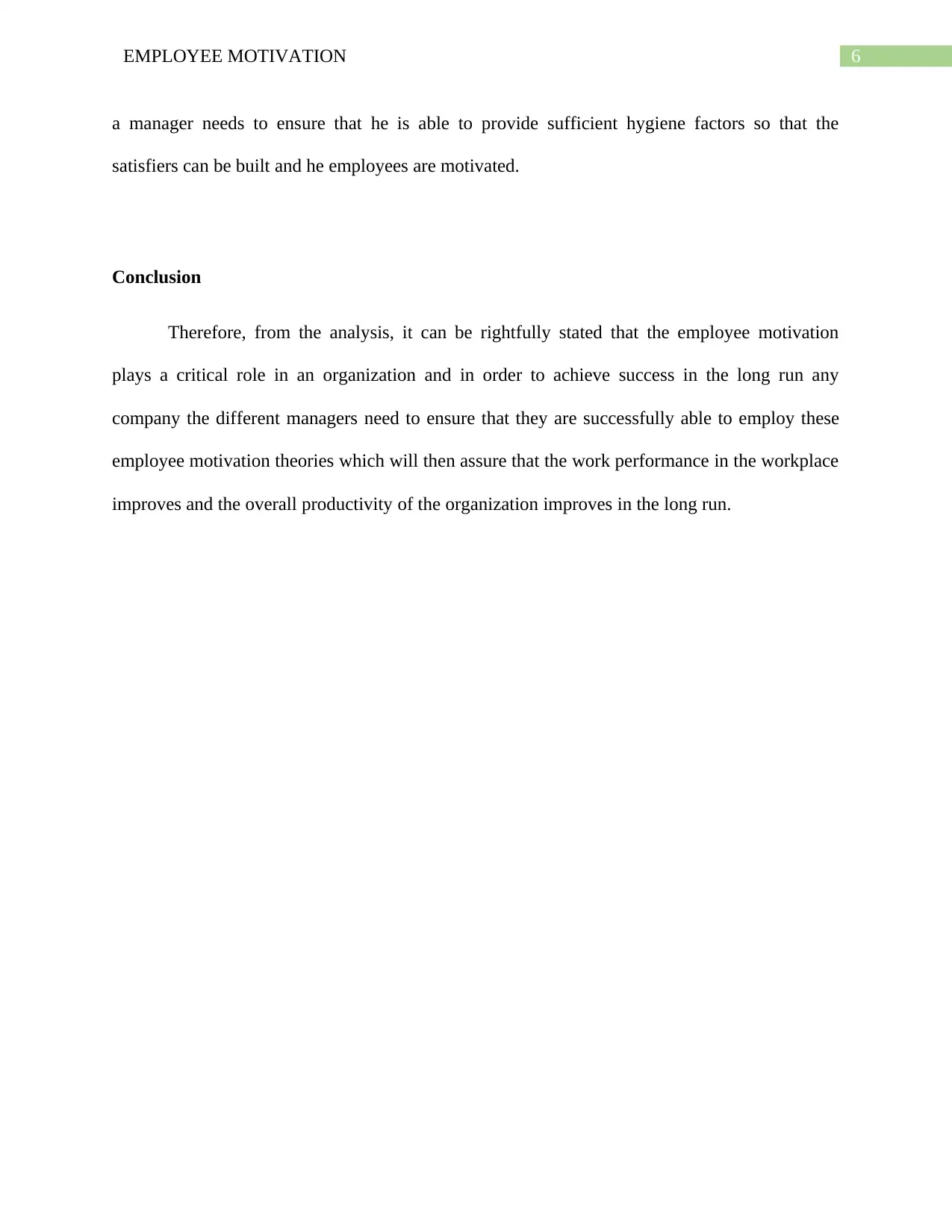
6EMPLOYEE MOTIVATION
a manager needs to ensure that he is able to provide sufficient hygiene factors so that the
satisfiers can be built and he employees are motivated.
Conclusion
Therefore, from the analysis, it can be rightfully stated that the employee motivation
plays a critical role in an organization and in order to achieve success in the long run any
company the different managers need to ensure that they are successfully able to employ these
employee motivation theories which will then assure that the work performance in the workplace
improves and the overall productivity of the organization improves in the long run.
a manager needs to ensure that he is able to provide sufficient hygiene factors so that the
satisfiers can be built and he employees are motivated.
Conclusion
Therefore, from the analysis, it can be rightfully stated that the employee motivation
plays a critical role in an organization and in order to achieve success in the long run any
company the different managers need to ensure that they are successfully able to employ these
employee motivation theories which will then assure that the work performance in the workplace
improves and the overall productivity of the organization improves in the long run.
Paraphrase This Document
Need a fresh take? Get an instant paraphrase of this document with our AI Paraphraser
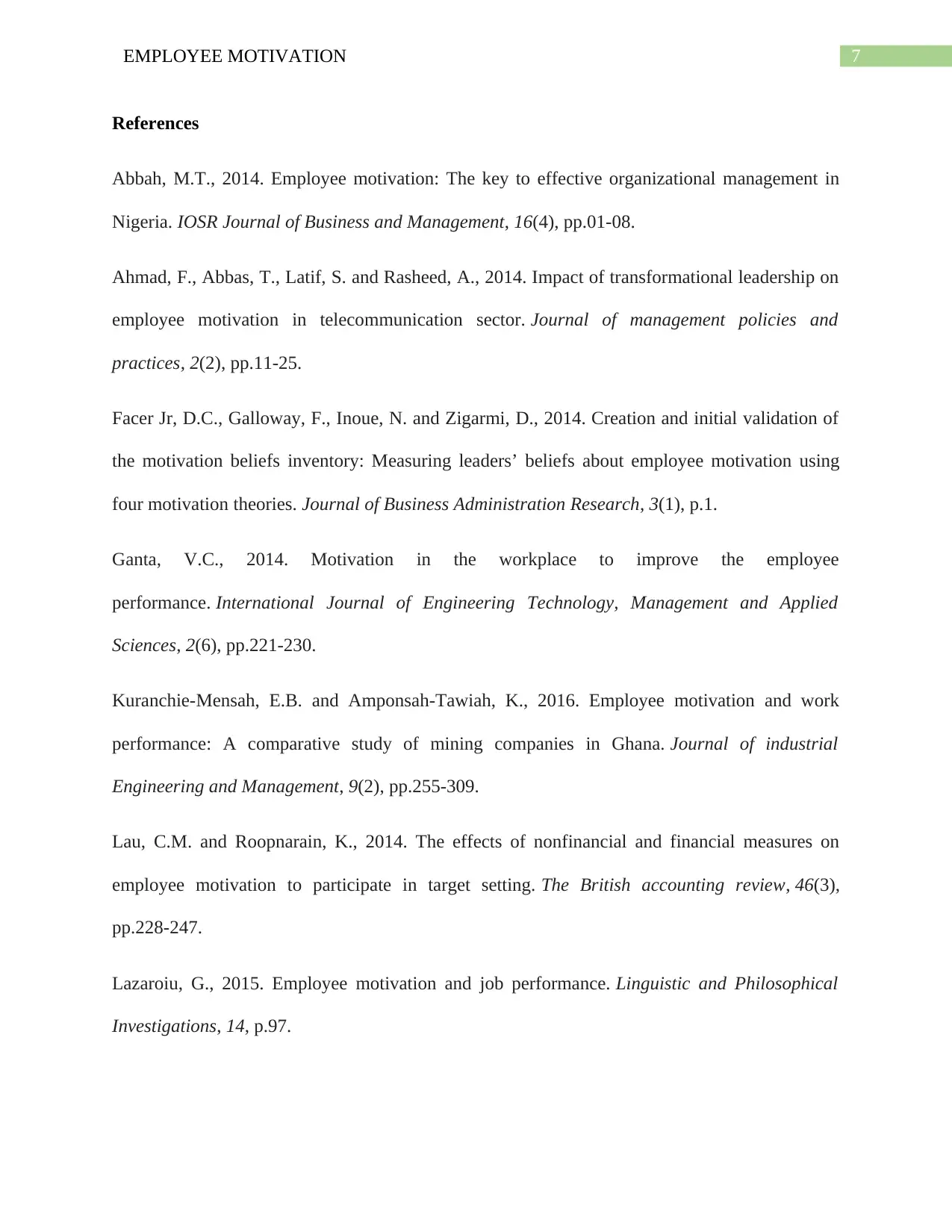
7EMPLOYEE MOTIVATION
References
Abbah, M.T., 2014. Employee motivation: The key to effective organizational management in
Nigeria. IOSR Journal of Business and Management, 16(4), pp.01-08.
Ahmad, F., Abbas, T., Latif, S. and Rasheed, A., 2014. Impact of transformational leadership on
employee motivation in telecommunication sector. Journal of management policies and
practices, 2(2), pp.11-25.
Facer Jr, D.C., Galloway, F., Inoue, N. and Zigarmi, D., 2014. Creation and initial validation of
the motivation beliefs inventory: Measuring leaders’ beliefs about employee motivation using
four motivation theories. Journal of Business Administration Research, 3(1), p.1.
Ganta, V.C., 2014. Motivation in the workplace to improve the employee
performance. International Journal of Engineering Technology, Management and Applied
Sciences, 2(6), pp.221-230.
Kuranchie-Mensah, E.B. and Amponsah-Tawiah, K., 2016. Employee motivation and work
performance: A comparative study of mining companies in Ghana. Journal of industrial
Engineering and Management, 9(2), pp.255-309.
Lau, C.M. and Roopnarain, K., 2014. The effects of nonfinancial and financial measures on
employee motivation to participate in target setting. The British accounting review, 46(3),
pp.228-247.
Lazaroiu, G., 2015. Employee motivation and job performance. Linguistic and Philosophical
Investigations, 14, p.97.
References
Abbah, M.T., 2014. Employee motivation: The key to effective organizational management in
Nigeria. IOSR Journal of Business and Management, 16(4), pp.01-08.
Ahmad, F., Abbas, T., Latif, S. and Rasheed, A., 2014. Impact of transformational leadership on
employee motivation in telecommunication sector. Journal of management policies and
practices, 2(2), pp.11-25.
Facer Jr, D.C., Galloway, F., Inoue, N. and Zigarmi, D., 2014. Creation and initial validation of
the motivation beliefs inventory: Measuring leaders’ beliefs about employee motivation using
four motivation theories. Journal of Business Administration Research, 3(1), p.1.
Ganta, V.C., 2014. Motivation in the workplace to improve the employee
performance. International Journal of Engineering Technology, Management and Applied
Sciences, 2(6), pp.221-230.
Kuranchie-Mensah, E.B. and Amponsah-Tawiah, K., 2016. Employee motivation and work
performance: A comparative study of mining companies in Ghana. Journal of industrial
Engineering and Management, 9(2), pp.255-309.
Lau, C.M. and Roopnarain, K., 2014. The effects of nonfinancial and financial measures on
employee motivation to participate in target setting. The British accounting review, 46(3),
pp.228-247.
Lazaroiu, G., 2015. Employee motivation and job performance. Linguistic and Philosophical
Investigations, 14, p.97.
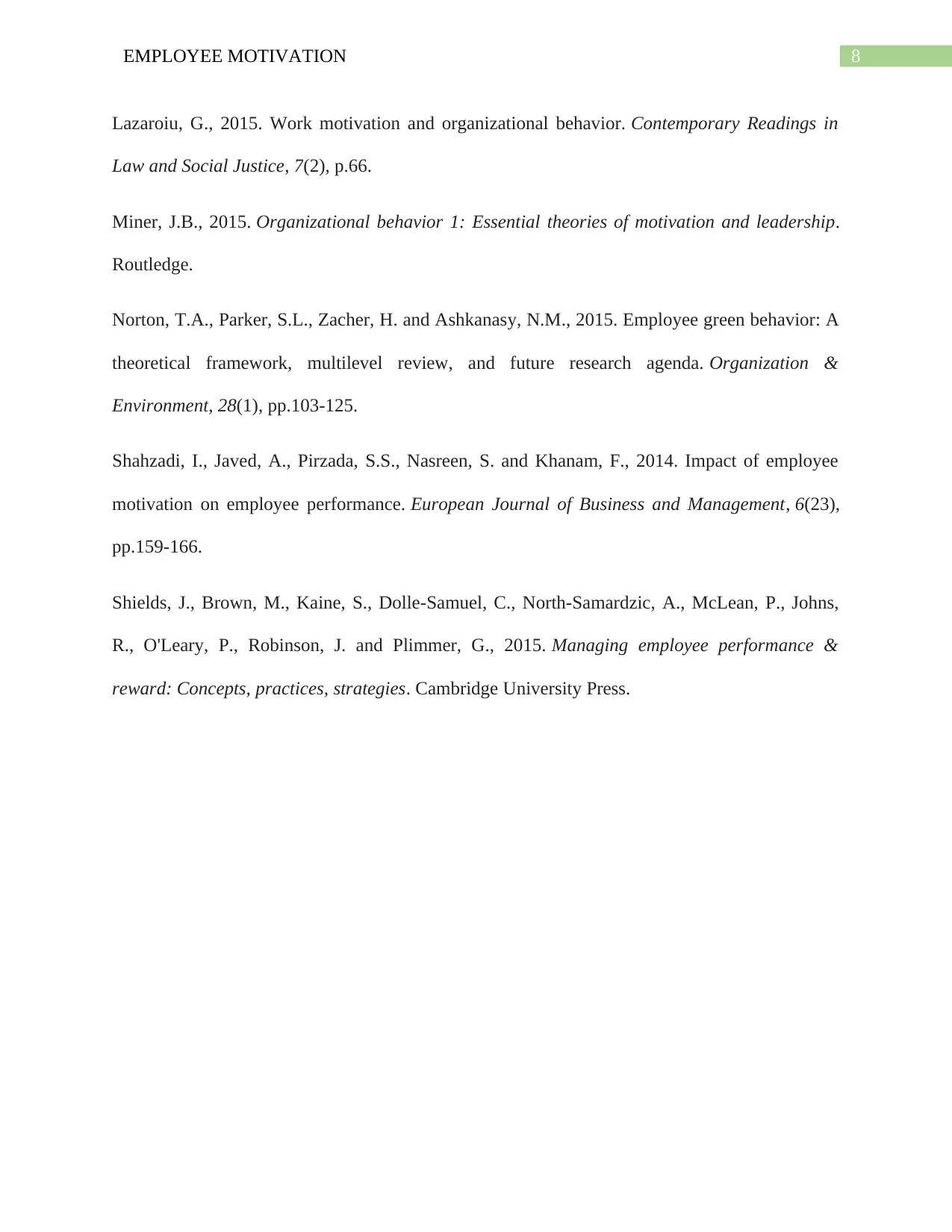
8EMPLOYEE MOTIVATION
Lazaroiu, G., 2015. Work motivation and organizational behavior. Contemporary Readings in
Law and Social Justice, 7(2), p.66.
Miner, J.B., 2015. Organizational behavior 1: Essential theories of motivation and leadership.
Routledge.
Norton, T.A., Parker, S.L., Zacher, H. and Ashkanasy, N.M., 2015. Employee green behavior: A
theoretical framework, multilevel review, and future research agenda. Organization &
Environment, 28(1), pp.103-125.
Shahzadi, I., Javed, A., Pirzada, S.S., Nasreen, S. and Khanam, F., 2014. Impact of employee
motivation on employee performance. European Journal of Business and Management, 6(23),
pp.159-166.
Shields, J., Brown, M., Kaine, S., Dolle-Samuel, C., North-Samardzic, A., McLean, P., Johns,
R., O'Leary, P., Robinson, J. and Plimmer, G., 2015. Managing employee performance &
reward: Concepts, practices, strategies. Cambridge University Press.
Lazaroiu, G., 2015. Work motivation and organizational behavior. Contemporary Readings in
Law and Social Justice, 7(2), p.66.
Miner, J.B., 2015. Organizational behavior 1: Essential theories of motivation and leadership.
Routledge.
Norton, T.A., Parker, S.L., Zacher, H. and Ashkanasy, N.M., 2015. Employee green behavior: A
theoretical framework, multilevel review, and future research agenda. Organization &
Environment, 28(1), pp.103-125.
Shahzadi, I., Javed, A., Pirzada, S.S., Nasreen, S. and Khanam, F., 2014. Impact of employee
motivation on employee performance. European Journal of Business and Management, 6(23),
pp.159-166.
Shields, J., Brown, M., Kaine, S., Dolle-Samuel, C., North-Samardzic, A., McLean, P., Johns,
R., O'Leary, P., Robinson, J. and Plimmer, G., 2015. Managing employee performance &
reward: Concepts, practices, strategies. Cambridge University Press.
⊘ This is a preview!⊘
Do you want full access?
Subscribe today to unlock all pages.

Trusted by 1+ million students worldwide
1 out of 9